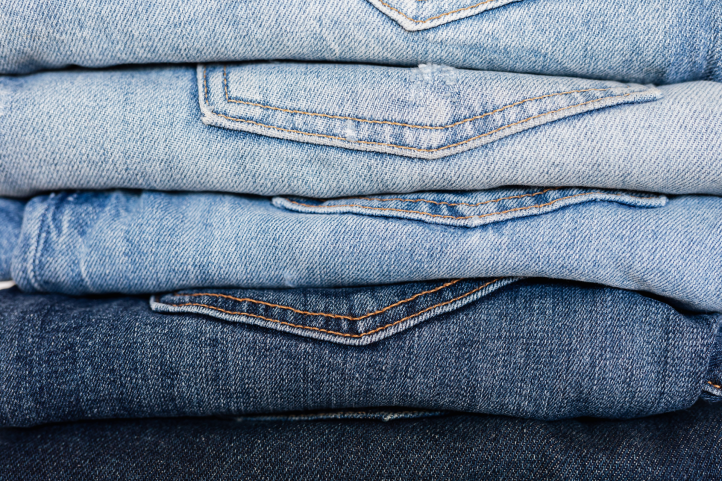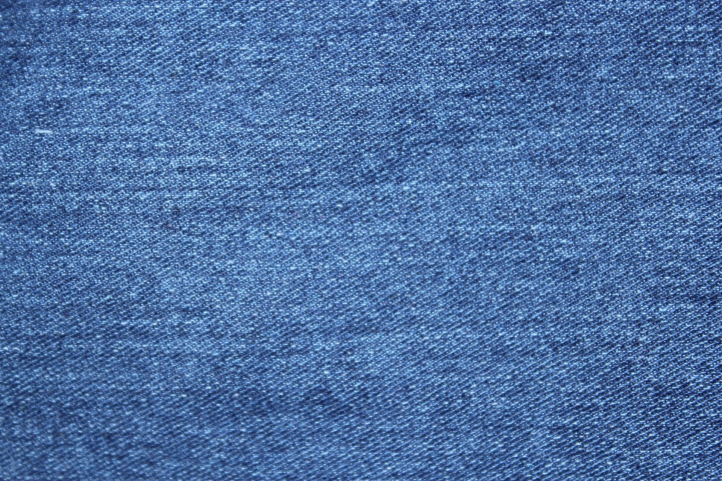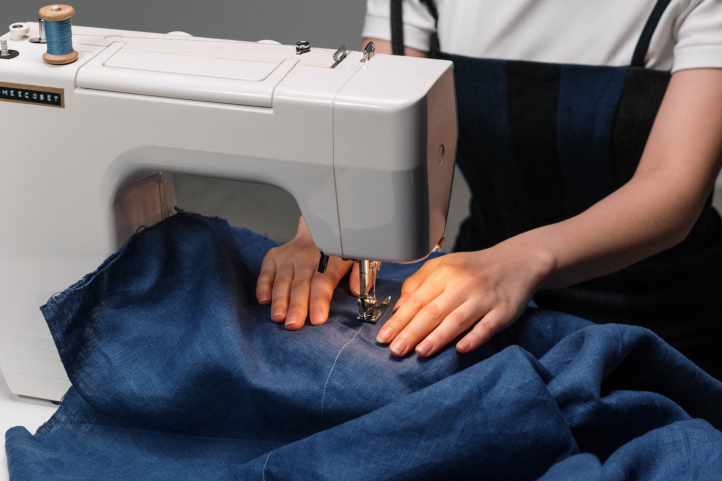
Denim is easily one of the most recognizable types of cotton fabric known to sewists and shoppers alike. But have you ever stopped to consider just how many different kinds of denim exist in the world or what type of denim you have in your closet? Do you know the difference between dry denim and stretch denim? How often do you stop and think about the fabrics your wardrobe holds?
Sewists are familiar with how important the composition of fabrics is to the sewing process and overall garment construction, as different fabric weights and stretch (or lack thereof) can drastically affect a finished garment. If you’ve been dreaming of sewing your own pair of perfectly fitted jeans but feel lost when you enter the denim aisle of your fabric store, then you won’t want to miss our quick guide to different types of denim that you need to know about. We’re covering the most common types of denim that you’ll find in both fabric stores and retail shops, as well as give a run-down on the basics of denim fabric.
In need of a few fast tips for sewing denim? No worries! We’ve got you covered. Learn the ins and outs of this forever-popular jean-ius fabric in our list of the types of denim that you need to know.
What Is Denim?

Let’s take a moment to discuss what denim is and what denim is used for. According to the article “Different Types of Denim” from Textile Engineering, denim is a fabric made from twill cotton that features unique ribbing that distinguishes it from other similar types of cotton fabric, such as cotton duck. The word “denim” is thought to have originated in France and refers to the indigo dye traditionally used in the creation of this fabric. Denim is well known for its durability, and is most commonly associated with jeans, made popular by Levi Strauss as workwear in the 1870s.
Denim’s unique characteristics, combined with its sturdiness, have made it an iconic fabric with enduring popularity. Often used in jeans, jackets and other fashion garments, denim has a fairly good drape despite its thickness; according to Sarina Tariq in their article “Denim fabric: (Characteristics and different types)” for Sew Guide, this is due to its “twill diagonal weave”. Tariq also notes that the unique weaving process of denim leads to the trademark look of dark blue on the outside of denim garments and lighter or white on the inside. Denim is also sold in different weights, so it’s important to consider what weight works best for the type of pattern you will be sewing.
Now that we’ve covered the basics of denim, let’s take a quick look at the most common types of denim that you need to know.
Different Types of Denim

While this is by no means an exhaustive list of different denim variations, our handy quick guide will cover the basic types of denim you’ll encounter both as a sewist and consumer.
- Dry Denim – Also known as raw denim or unwashed denim, this type of denim is not washed after the dying process and has a stiff feel compared to washed denims. Raw denim has an even coloring (compared to distressed washes found in some ready-to-wear garments) and due to this, it is important to prewash your raw denim before sewing. (For tips about whether to prewash fabric, check out our article here!) According to Tariq, this even, dark coloring is why dry denim is considered a superior denim.
- Washed Denim – Unlike dry denim, washed denim is washed after the fabric is dyed; this is done to prevent the fabric from shrinking and the color from bleeding. According to the article “Different Types of Denim Explained” from Dalston Mills Fabrics, “most denim fabrics are sold as washed”.
- Stretch Denim – Stretch denim is a type of denim often found in ready-to-wear jeans and is known for its ability to comfortably stretch with the wearer’s body. This type of denim is made using stretch fibers using elastane such as Lycra or Spandex. Stretch denim does not wrinkle and is typically found in lighter weights (think stretchy jeggings compared to heavier workwear jeans).
- Selvage Denim – If you’re familiar with sewing your own garments, you are already familiar with what a selvage (or selvage edge) is. Selvage denim has a visible edge and is often found in unwashed denim, making it a higher quality denim. According to Textile Engineering, “Selvage is alluring because the edge cannot shred like lower-quality denims that have separate wefts”. The contrasting thread seen on selvage denim adds an attractive aesthetic touch to this type of fabric.
- Bull Denim – Bull denim is a heavy-weight denim known for its durability. This type of denim is not typically used for clothing and is instead found in upholstery and home décor items, although it can be found in garments and accessories that experience heavy wear, such as bags or aprons.
- Colored Denim – Colored denim is exactly as it sounds, denim that is made in colors besides traditional indigo. While blue denim is made using indigo dye, colored denim is made using a sulphur dyeing technique. Colored denim can be made in any color and is commonly found in colors like red, green, pink, black and yellow.
- Acid Wash Denim – If you lived through the ‘80s and ‘90s, you’re probably familiar with the look of acid wash denim. This type of denim is exposed to chlorine bleach to create a lighter, alternative look. Acid wash has its roots in stone washing, which dates back to the 1960s, in which jeans and/or denim is washed with stones to give the denim a stylish, worn appearance. It is important to note that stone washing denim can affect the longevity of the garment’s life span.
- Ecru Denim – Ecru denim, named for its pale beige or off-white color, is a type of denim that has not been dyed. The natural coloring of the fabric can give a garment a casual, lighter look, and is often found in jeans and jackets.
- Poly Blend Denim – Polyester blended denim features polyester blended into the denim and similar to other stretch denims, is known for its softness and stretch capabilities. Poly blend denim has a smoother finish than its 100% cotton counterparts and is found in many ready-to-wear garments. Like denim made with Spandex or Lycra, polyester blended denim also contains microplastics due to its synthetic nature.
Quick Tips for Sewing Denim

Now that we’ve discussed the types of denim you’re likely to encounter, let’s go over a few quick tips for sewing denim. These tips will help save you time and stop you from stressing when sewing this heavy-duty fabric.
- Prewash your fabric. As discussed earlier, denim is prone to shrinkage and the dye used in denim can easily bleed, so it’s important to prewash your fabric before you start cutting.
- Use a denim needle. Denim is a heavier weight fabric, and therefore, a thicker needle is advised. You can buy sewing needles specifically designed for sewing denim online.
- High quality, all-purpose thread can be used to sew denim. You can add decorative topstitching to your denim or embroidery details as well!
- Use a longer stitch length. Make some practice stitches on a piece of scrap fabric to check the stitch length and tension.
- Take your time, making sure not to pull your fabric. This will help prevent your needle from breaking.
What types of denim do you prefer to sew? Do you have any tips for your fellow readers? Feel free to share them in the comments below!
